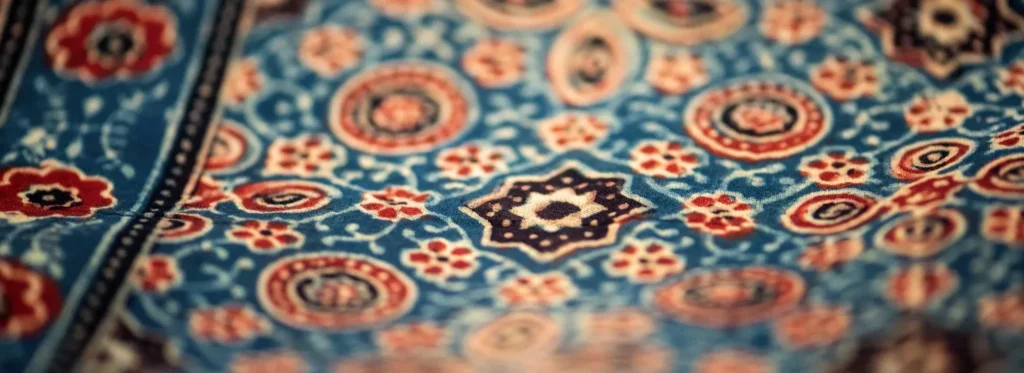Kutch Ajrakh: A Traditional Textile Craft Earns GI Tag
In the vibrant tapestry of India’s rich cultural heritage, the art of Ajrakh holds a significant place. Recently, this traditional textile craft, rooted in the arid lands of Kutch, Gujarat, has garnered attention by securing the prestigious Geographical Indication (GI) tag. The recognition not only celebrates the craft’s historical significance but also offers protection against unauthorized use, ensuring its legacy for future generations.

Why this News is Important:
Preservation of Cultural Heritage: The conferment of the GI tag on Kutch Ajrakh underscores the importance of safeguarding India’s diverse cultural heritage. Ajrakh, with its intricate patterns and vibrant colors, represents centuries-old traditions and craftsmanship passed down through generations. The GI tag serves as a shield against imitation and commercial exploitation, preserving the authenticity of this cultural gem.
Boost to Artisans and Economy: For the artisans of Kutch, the GI tag translates into tangible benefits. It not only enhances the marketability of their products but also opens avenues for increased recognition and revenue. With Ajrakh gaining prominence on the national and international stage, there’s a potential for economic empowerment and sustainable livelihoods in the region.
Revival of Traditional Crafts: In an era dominated by mass-produced goods, the resurgence of traditional crafts like Ajrakh is a testament to the enduring allure of handmade artistry. The GI tag not only acknowledges the skill and creativity of artisans but also encourages the preservation and revival of other indigenous crafts facing existential threats.
Cultural Exchange and Tourism: The recognition of Kutch Ajrakh as a GI product has the potential to attract cultural enthusiasts and tourists eager to explore India’s rich textile heritage. It presents an opportunity for cultural exchange and collaboration, fostering greater appreciation and understanding of traditional crafts among a global audience.
Empowerment of Artisans: By bestowing the GI tag, authorities have empowered the artisans of Kutch, granting them greater control over their intellectual property rights. This recognition not only instills pride within the artisan community but also reaffirms the value of their craftsmanship in the eyes of the world.
Historical Context:
Legacy of Ajrakh: Ajrakh traces its origins back to the ancient Indus Valley Civilization, where evidence of its existence has been found on archaeological artifacts. Over the centuries, this art form evolved, blending influences from various cultures and civilizations that traversed the region.
Revival Efforts: In recent decades, concerted efforts have been made to revive and promote traditional crafts like Ajrakh. Artisan cooperatives, government initiatives, and non-profit organizations have played a pivotal role in providing training, infrastructure, and market linkages to sustain these age-old practices.
Global Recognition: The journey of Ajrakh from local craft to global phenomenon is marked by milestones such as exhibitions, awards, and collaborations with renowned designers. Its inclusion in India’s GI registry further cements its status as a cultural treasure worthy of preservation and promotion.
Key Takeaways from “Kutch Ajrakh: A Traditional Textile Craft Earns GI Tag”
| Serial Number | Key Takeaway |
|---|---|
| 1. | Kutch Ajrakh, a traditional textile craft, has secured the prestigious Geographical Indication (GI) tag. |
| 2. | The GI tag ensures protection against unauthorized use, safeguarding the authenticity of Ajrakh. |
| 3. | The recognition enhances marketability, economic prospects, and cultural significance for artisans and the region. |
| 4. | Ajrakh’s journey reflects a larger trend of preserving and promoting India’s rich cultural heritage. |
| 5. | The GI tag empowers artisans, reaffirming the value of their craftsmanship and heritage. |
Important FAQs for Students from this News
1. What is Ajrakh?
Ajrakh is a traditional textile craft characterized by intricate patterns and vibrant colors, originating from the Kutch region of Gujarat, India.
2. What is the significance of the Geographical Indication (GI) tag?
The GI tag signifies that a product possesses qualities, reputation, or characteristics that are attributable to its geographical origin. In the case of Kutch Ajrakh, it ensures protection against unauthorized use and promotes its authenticity.
3. How does the GI tag benefit artisans?
The GI tag enhances the marketability of Ajrakh products, leading to increased recognition and revenue for artisans. It also empowers them by granting greater control over their intellectual property rights.
4. What is the historical background of Ajrakh?
Ajrakh has a rich historical legacy, with evidence of its existence dating back to the ancient Indus Valley Civilization. Over the centuries, it has evolved, incorporating influences from various cultures and civilizations.
5. How does the recognition of Kutch Ajrakh contribute to cultural exchange and tourism?
The recognition of Kutch Ajrakh as a GI product has the potential to attract cultural enthusiasts and tourists interested in exploring India’s rich textile heritage. It fosters cultural exchange, collaboration, and greater appreciation of traditional crafts on a global scale.
Some Important Current Affairs Links

















